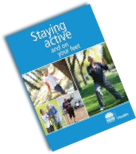As we age our vision changes: we find it harder to focus, our vision becomes less clear, we are more sensitive to glare, it takes longer to adjust to changes in light conditions and we also need better lighting to see well. Good vision helps us to maintain our balance when walking and standing and problems with vision can increase our risk of having a fall.
Some medical eye conditions that affect vision include:
- Age related Macular Degeneration (AMD) – affects a person’s central vision and makes reading and close work and recognising faces more difficult
- Cataracts – produces blurring that affects both near and distance vision and increases sensitivity to glare
- Glaucoma – leads to loss of peripheral vision
- Diabetic retinopathy – causes blurriness of vision and can lead to blindness
Each of these conditions can lead to an increased risk of an injurious fall due to loss of:
- visual acuity leading to loss of ability to distinguish detail clearly e.g. edges of kerbs/gutters or steps, cracks in pavements
- visual field leading to loss of central vision or tunnel vision e.g. not being able to see things in one’s surroundings
- depth perception which makes it difficult to judge the relative distance and position of objects such as steps or kerbs/gutters
- contrast sensitivity which makes it difficult to distinguish between light and dark surface changes such as cracks in pavements and floor surfaces
Tips for Staying Safe with Eye problems
- Regular eye checks will pick up any eye problems early and provide referral for interventions (such as cataract removal), treatment for certain eye conditions such as AMD and optimal prescription glasses. See the Optometrists Association of Australia at http://www.optometrists.asn.au/ to locate your nearest optometrist.
- It has been found that the use of bifocal and multifocal glasses particularly outdoors increases the risk of falling and it is recommended that single-lens distance glasses with lenses that go darker be used outdoors to reduce glare.
- Wear a hat and sunglasses (or single lens distance glasses with lenses that go darker outdoors to reduce glare.
- A home safety assessment is recommended, this can minimise environmental hazards and improve visual cues. This can be carried out by an Occupational Therapist.
- Give your eyes time to adjust to changes in light conditions and have good lighting at home including sensor lights in stairs and hallways.
- Regular exercise especially that which includes balance and strength components improves balance, muscle strength and flexibility.
- Consider orientation training and the use of aids if you have low vision and need help to navigate around your community.
A number of good resources are available including:
Understanding vision loss from the Macular Disease Foundation Australia. This booklet is free and available to view online, download or order. ‘Understanding vision loss’ discusses the various degrees of vision loss, from reduced vision, to low vision and legal blindness. Having a better understanding of what impaired vision is, as well knowing what support is available, could help you feel more confident and maintain quality of life.
Living well with vision loss. This booklet is free and available to view online, download or order. The booklet answers the questions often asked by people with vision loss, their families and carers. It also highlights how aids and technologies can help you improve quality of life and independence.
Low Vision Aids and Technology: A Guide. This resource provides information on a range of low vision aids and technology.
Other Links
GuideDogs NSW /ACT
Macular Disease Foundation Australia
Vision Australia
REFERENCES
Macular Degeneration Foundation
Neuroscience Research Australia

